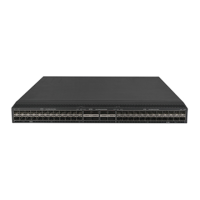13
A port's link type determines the type of BPDUs the port sends.
• An access port sends RSTP BPDUs.
• A trunk or hybrid port sends RSTP BPDUs in the default VLAN and sends PVST BPDUs in
other VLANs.
How PVST works
PVST implements per-VLAN spanning tree calculation by mapping each VLAN to an MSTI. In PVST,
each VLAN runs RSTP independently to maintain its own spanning tree without affecting the
spanning trees of other VLANs. In this way, loops in each VLAN are eliminated and traffic of different
VLANs is load shared over links. PVST uses RSTP BPDUs in the default VLAN and PVST BPDUs in
other VLANs for spanning tree calculation.
PVST uses the same port roles and port states as RSTP for rapid transition. For more information,
see "Basic concepts in RSTP."
About MSTP
MSTP features
Developed based on IEEE 802.1s, MSTP overcomes the limitations of STP, RSTP, and PVST. In
addition to supporting rapid network convergence, it allows data flows of different VLANs to be
forwarded along separate paths. This provides a better load sharing mechanism for redundant links.
MSTP provides the following features:
• MSTP divides a switched network into multiple regions, each of which contains multiple
spanning trees that are independent of one another.
• MSTP supports mapping VLANs to spanning tree instances by means of a VLAN-to-instance
mapping table. MSTP can reduce communication overheads and resource usage by mapping
multiple VLANs to one instance.
• MSTP prunes a loop network into a loop-free tree, which avoids proliferation and endless
cycling of frames in a loop network. In addition, it supports load balancing of VLAN data by
providing multiple redundant paths for data forwarding.
• MSTP is compatible with STP and RSTP, and partially compatible with PVST.
MSTP protocol frames
Figure 8 shows the format of an MSTP BPDU.

